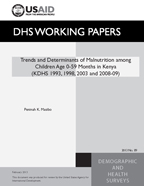
Abstract:
Objectives: The study was conducted to
determine trends of undernutrition and
overnutrition among children age 0 to 59
months in Kenya and to analyze the
determinants of child undernutrition and
overnutrition.
Data and methods: The study analysed data
from the Kenya Demographic and Health Surveys
(KDHS) 1993, 1998, 2003, and 2008-09. The
study examined the trends in malnutrition
over the four surveys and the relationship
between malnutrition and selected household,
maternal, and child characteristics.
Results: The levels of stunting and
underweight declined significantly (P<0.05)
over the study period, by 4.6 percentage
points. Nonetheless, stunting remains of high
public health significance in Kenya, while
underweight is of medium public health
significance, as per the World Health
Organization (WHO) classification (WHO 1995).
Household wealth index, maternal education,
maternal Body Mass Index (BMI), and size of
the child at birth were significant
determinants of child undernutrition.
Conclusion and recommendations:
The effect of wealth index, maternal
education, and maternal BMI on child
undernutrition changed over time, with wealth
and maternal education having a reduced
effect. The results suggest an emerging trend
of a double burden of malnutrition, with
stunted children whose mothers are
overweight. The implementation of national
nutrition strategies should focus on the
vulnerable groups. Increasing women’s access
to secondary and post-secondary education
would go a long way in harnessing the
potential of improved maternal and child
nutrition in the country.
 Trends and Determinants of Malnutrition among Children Age 0-59 Months in Kenya (KDHS 1993, 2003 and 2008-09) (PDF, 549K)
Trends and Determinants of Malnutrition among Children Age 0-59 Months in Kenya (KDHS 1993, 2003 and 2008-09) (PDF, 549K)
